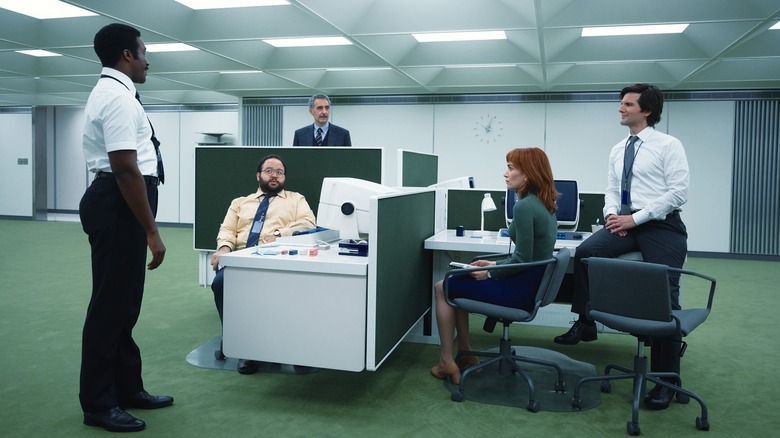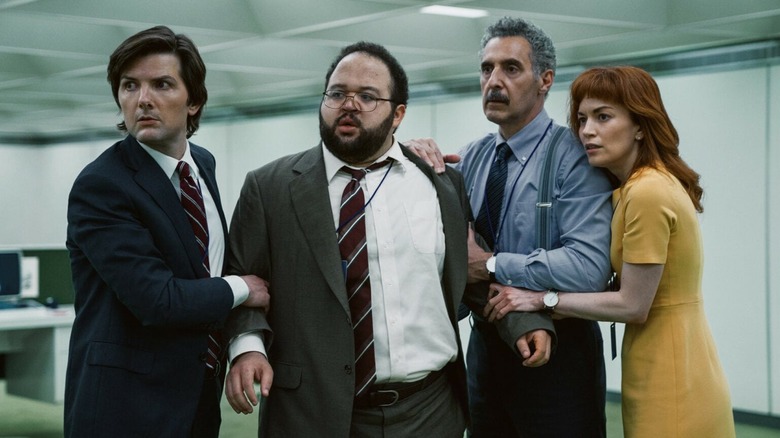Why Severance Feels So Claustrophobic, According To The Production Designer
On Dan Erickson's hit corporate dystopia series "Severance," the four lead characters — Mark S. (Adam Scott), Helly R. (Britt Lower), Dylan G. (Zach Cherry), and Irving B. (John Turturro) — work on a lower floor of Lumon Industries, a secretive and mysterious company that produces ... something. The four work in the macrodata refinement department, and it's their job to sort numbers into digital boxes. They are achieving ... something. Their office is located deep within the Lumon building, and their desks are all clustered together in an outsize room, carpeted by a '60s-green carpet and lit by oppressive fluorescent bulbs. Because Lumon employees have had their memories surgically "severed" from the outside world, the Lumon office is technically the only world the employees have ever known.
To get to the green-carpeted room, Lumon employees have to exit an elevator and walk a very, very long stroll through a labyrinth of narrow, plain-white corridors. The sets build for "Severance" are enormous, and actors reportedly got lost in the very real maze that the set-builders put together. The opening scene of season 2 of "Severance" was virtuosic in depicting the maze-like qualities of the eerie Lumon hallways. It also left Adam Scott utterly tuckered out. Season 2 also revealed that there is a secondary basement below the one the macrodata refinement people work, where Gemma (Dichen Lachman) has been kept prisoner.
Many reviews will describe "Severance" as a claustrophobic show, and it's not just because the four main characters rarely see the sky. It feels cramped. Imposing. Like the ceiling is closing in. There's a reason for that. The show's production designer, Jeremy Hindle, recently spoke with the Hollywood Reporter about the sets and designs for "Severance," and he revealed a simple trick for making a cinematic space look cramped: just point the camera at the ceiling.
Severance feels cramped because the ceiling is visible
It should be remembered that the vast bulk of TV and movie sets are built without ceilings, often to accommodate lighting, rigging, and other technical equipment. It's okay to build sets this way because low angles are easy to avoid. Just keep the camera at a natural eye-line, or lift it up and angle it down, and it will create a wider and better sense of spatial continuity. Because of this, on-screen ceilings, at least in everyday spaces like offices and houses, have come to be seen as oppressive and unusually short. Hindle knew this, and was able to get an eerie, boxed-in feeling just by making sure the ceilings were visible.
It also, he said, aided his idea of how to light "Severance." Open ceilings allow for strong, cinematic lights to be employed. A ceiling demands more naturalistic lighting. As he put it:
"TV sets never have ceilings, ever. And you can tell by the lighting. I always build ceilings. [...] [It's] a huge fire problem. [...] I think that's why the show has such a nice physical feeling to it because it feels lit like a real place. [...] It was supposed to feel like you're always kind of lost."
The second season of "Severance" recently ended, with Mark and Helly fleeing into the Lumon building happy to be together, but unsure where they might go; if they leave the building, they'll effectively cease to exist; their brains will flip back to their outside-Lumon selves.
Audiences may be lost, but Hindle was sure to draw a map. The makers of "Severance" know exactly where everything is, and Hindle even showed off one of his blueprints for the Hollywood Reporter article. One may be able to grasp Lumon's geography with such a diagram. Although I would certainly still get lost in the hallways were I there in person.

